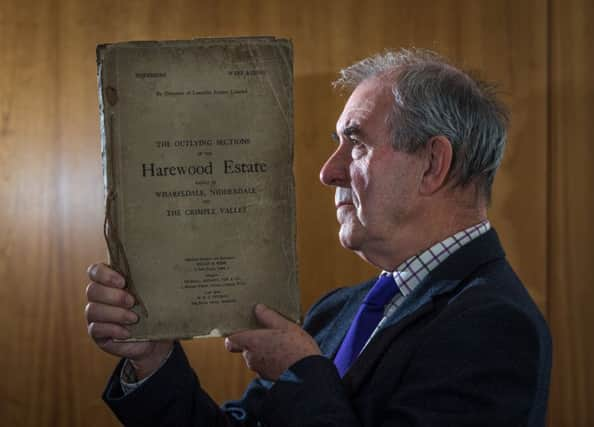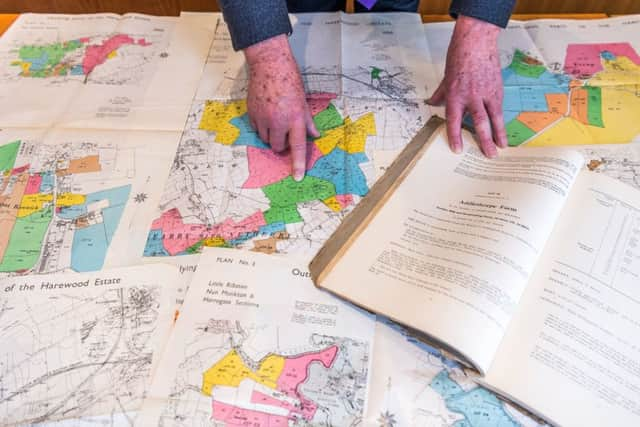The time a land sale at £50 an acre saved Harewood


In one of the biggest property transactions of its time, thousands of acres of farmland went under the hammer – its disposal deemed crucial to keeping the main house and park intact.
The deals created the patchwork of plots that defines a part of the West Riding to this day – yet ironically its relinquishment by the peerage appears to have been triggered by the death of the King’s brother-in-law.
Advertisement
Hide AdAdvertisement
Hide AdThe fading, cloth-bound details of the arrangements by which the Lascelles family disposed of Harewood’s outer estate, thought to have been lost to time, have emerged during an office move at a firm of Leeds property consultants.


Within the corridors of Sanderson Weatherall’s premises on the corner of Thirsk Row were discovered not only the Harewood papers but also plans drawn up in the 1940s and 50s for the sale of land on which the Yorkshire Sculpture Park now stands, and for the redevelopment of Leeds centre – with the tunnels for the city’s inner ring road drawn in, decades before they were built.
For one of the firm’s consultants, the discovery had personal as well as historic significance, for the handwriting of the auctioneer – sometimes in an arcane estate agent’s code – was that of his father.
“It feels like so long ago that you can hardly believe it’s tangible,” said David Richardson, flicking through the hand-drawn papers.
Advertisement
Hide AdAdvertisement
Hide AdThe plans reveal that the present-day Harewood Estate, which includes the stately house and its grounds north of Leeds, once extended far beyond, and took in the villages of Weeton, Dunkeswick, Kirkby Overblow and parts of Pannal on the road out to Harrogate.


The outer estate comprised farmland, much of it tenanted out to smallholders whose families had worked it for generations. But the death in 1947 of Henry Lascelles, sixth Earl of Harewood, is thought to have forced the family into a wholesale sell-off.
Death duties of up to 80 per cent had been imposed by the post-war Labour government and the aristocracy was hit hard. Property was sold off to settle the bills and many stately homes demolished to avoid being liable for probate duty.
With no legislation to protect buildings of historic significance, demolition was a private act between owner and builder, and it is estimated that more than 1,000 were reduced to rubble.
Advertisement
Hide AdAdvertisement
Hide AdThe habitable part of Hornby Castle, on the edge of Wensleydale between Bedale and Leyburn, was razed after the Duke of Leeds sold it off and moved to the Riviera. It had dated back to the Middle Ages.
Mathematics saved Harewood from a similar fate after the death of the sixth Earl, a World War One commander who had married Princess Mary, daughter of George V and brother to the reigning King.
“They would have worked out that if they sold enough of the outer estate they would be able to meet the tax bill and secure the house and inner estate,” Mr Richardson said.
The eventual sale, in 1950, disposed of 99 lots, covering some 7,600 acres, and raised £256,000 – more than £9m at today’s prices. The average price of an acre at the time of the sale was just £50.
Advertisement
Hide AdAdvertisement
Hide AdBut the columns of pounds, shillings and pence often contained letters instead of numbers, with agents, when they needed to keep the sums private, using a code word whose letters corresponded to digits.
Harewood House had been taken over by the Red Cross during the Second World War and the newly discovered documents include an inventory of the family treasures left inside, sometimes written in endearingly vague terms such as “portrait of a gentleman”.
The files also take in the sale by Viscount Allendale of 3,334 acres of the Bretton Estate near Wakefield, in the 1950s. The land later housed part of Bretton Hall College and is now the site of the Yorkshire Sculpture Park.
Mr Richardson said: “I’m sure the story there is exactly the same as at Harewood.”
Sanderson Weatherall, which is moving to the new Central Square development in Leeds, has presented the files to the city archive.